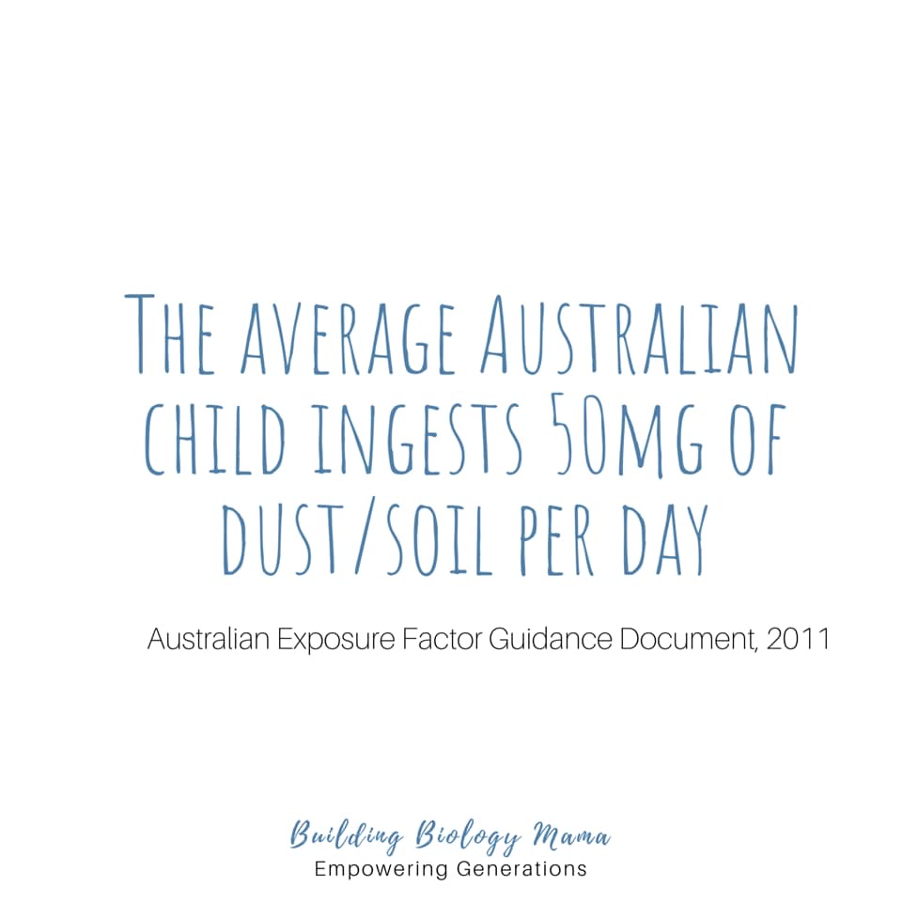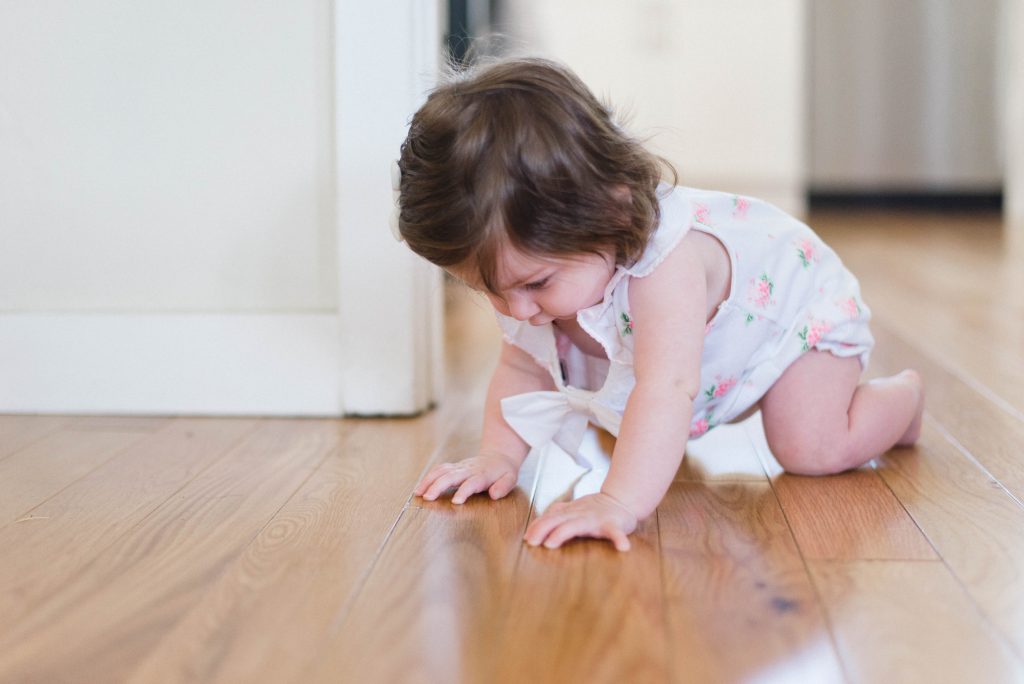The average dust/soil ingestion rate for Australian children is 50mg/day (Australian Exposure Factor Guideline, 2011). “Yeah so” might be your reaction. I’m sure a few of you may have even heard stories of yourself or siblings eating dirt when they were little, and I am sure you are thinking ‘we turned out ok’.
Well it is not necessarily the dirt that is the problem, the dirt may even be beneficial if you subscribe to the Hygiene Hypothesis or the newly coined Microbial Diversity Hypothesis. The Hygiene Hypothesis has evolved since Dr. David Strachan coined the term after his observations of 17,414 children born in 1958 which he followed up to the age of 23 years old. Nevertheless, the Hygiene Hypothesis and Microbial Diversity Hypothesis prescribes that, via a range of mechanisms in the body, early childhood exposure to microorganisms contributes to the development of a healthy immune system as well as provides protection against the development of allergic diseases and autoimmune disorders such as asthma. In fact, if you ask me, I personally say get children outside and amongst the dirt despite the controversary.
But it isn’t the microorganisms that I am referring to. It is what is hijacking a ride on the dust and dirt to which I am concerned about.
You see, children are more vulnerable to contaminant exposures due to their size and developmental stage. They are also more susceptible to dust exposure because they have a higher hand-to-mouth activity than other age groups, and their breathing zone tends to be closer to floors.
So, What is in Household Dust?
Indoor dust is a combination of particulate matter (particles) from both indoor and outdoor sources, and dirt and dust can act as a medium to transport toxins such as heavy metals and toxic chemicals.
In fact, the concentrations of chemicals in residential dust are seen as a useful indicator of indoor chemical exposure levels (Whitehead et al, 2011).
Trace Metals in Dust
Australian data collected as part of a global citizen science program called Dustsafe analysed 224 residential Sydney indoor household dust samples for metals and trace metals (Doyi et al, 2019).
The study found that older homes are significantly more lead contaminated than new homes; older homes which had recently completed extensive renovations returned the highest concentrations of lead levels; houses over 50 years with internal peeling paint also had higher average lead concentrations (Doyi et al, 2019).
Over 22% of dust samples were found to contain more than the maximum Australian guideline for lead in soil of 300mg/kg! The study concluded that “The US EPA IEUBK model data indicate that levels of indoor dust Pb (lead) concentrations determined in this study could cause child PbB exposures above acceptable levels (>5μg/dL) in certain locations. Consequently, this may have implications for childhood IQ and educational outcomes” (Doyi et al, 2019). Worse still, previous research has indicated that the adverse effects of lead on a child’s intelligence quotient (IQ) exist even at low concentrations, that is below 5μg/dL.
Something to sit up and listen to hey!
The study also found that several of the indoor dust trace metals (As, Mn, Pb, Zn) were significantly associated with residential soil metal values from the same location (Doyi et al, 2019). This suggests, that exterior sources of these contaminants are contributing to trace metal loads measured inside homes. Contaminants released into the atmosphere from industry, city traffic, topsoil remobilisation and building materials have the potential to be either deposited directly into homes or tracked-in on footwear.

Brominated Flame Retardants in Dust
Unfortunately, it is not just metals that have been found in household dust that are of concern. Brominated flame retardants, including Polybrominated diphenyl ethers (PBDEs) used in home furnishings, textiles and electronics (US EPA, 2010), have been detected in household dust, indoor air and even in food. It is no surprise that they are subsequently found in human tissue too as a result (Messer, 2010). PBDEs have been implicated as having an effect on thyroid function and neurodevelopment. In fact, PBDEs are known to be able to cross the placenta during pregnancy and effect the neurodevelopment of fetuses (Messer, 2010; Gibson et al, 2018; Vuong et al, 2018).
Polychlorinated Biphenyls in Dust
Polychlorinated biphenyls (PCBs) are another group of toxic chemicals that have been found in household dust levels. Although the scientific literature indicates that residential dust is generally a minor contributor to one’s PCB intake, some studies have shown that indoor dust levels may contribute substantially to PCB intake for young children living in highly contaminated homes (Whitehead et al, 2011). PCBs are present in electrical equipment such as televisions and refrigerators and building materials such as wood floor finishes and fluorescent lighting. Exposure to PCBs are associated with an increased risk of type 2 diabetes, hypertension, obesity, cardiovascular disease and even neurological deficits (Perkins, 2016; Gupta et al, 2018).
Polycyclic Aromatic Hydrocarbons in Dust
Indoor levels of polycyclic aromatic hydrocarbons (PAHs) can originate from both internal and external sources. External sources include vehicle exhaust and internal sources include cigarette smoke, wood-burning fireplaces, gas appliances, and charred foods. Whitehead et al (2011), states that benzo(a)anthracene, chrysene, benzo(b)fluoranthene, benzo(k)fluoranthene, benzo(a)pyrene, indeno(1,2,3-c,d)pyrene, and dibenzo(a,h)anthracene are seven PAHs most commonly reported in residential dust and have been classified by the U.S. Environmental Protection Agency as probable carcinogens.
Phthalates in Dust
Phthalates are commonly used in PVC plastics, latex products, cosmetics, personal care products including fragrances, cellulose plastics, children’s toys, food packaging, and household furnishings. Disturbingly they have been found in food and also household dust. I say disturbingly because phthalates are a known endocrine disruptor and are associated with infertility, testicular dysgenesis, obesity, asthma, and allergies, as well as leiomyomas (also known as fibroids are a type of tumour) and breast cancer to just to name a few (Crinnion, 2010). Crinnion (2010) states that phthalates appear to cause more damage to male reproduction when the exposure occurs during male fetal development too, which is yet another example of why people planning to start a family should look at and potentially modify their environment and lifestyle.
Bisphenol A
Bisphenol A (BPA) is a synthetic compound used in the production of many polycarbonate plastics and epoxy resins. Whilst BPA is most commonly associated with and found in most canned goods and plastics it has been documented in household dust (Mileva et al, 2014)! Yep dust, that’s not a typo. And yes, the primary source of BPA exposure in us is thought to occur through ingestion; however, absorption through our skin and inhalation of contaminated airborne dust are thought to be probable secondary routes. BPA is a known endocrine disruptor with the potential to cause adverse health effects that affect fetuses, children and adults (Rochester, 2013; Surendranath et al, 2017; Murata & Kang, 2018).
Solutions
Dust has a capacity to harbour toxic chemicals and metals, therefore keeping indoor dust levels down will assist in minimising our exposure especially for our littlest family members.
Although not all internal household levels of trace metals are associated with external sources, it is one source. So, while occupant behaviour and building materials may contribute to trace metal accumulation in dust (amongst other environmental contaminants but that’s to be explored another day), Building Biologists will always make the simple recommendation of taking off your shoes before going indoors to assist with external contaminate sources being minimised.
Another way to keep the internal dust load down is, wait for it, effectively dust regularly. Sounds obvious I know and at the risk of sounding silly, I am really serious. Part of my Building Biology consultation follow up always consists of demonstrating how to effectively wet dust using (if possible eco-friendly) microfibre cloths. Do away with dry dusting, it is ineffective at removing all the dust and you are more likely moving the dust around and making it airborne.
Last but not least, the number one necessity a Building Biologist will always recommend in every household is a vacuum cleaner with a true HEPA filter, and if you have carpets or rugs a motorised head is a must too.
As an optional extra, (a must in our household) is an air purifier. I know what you are thinking, but that’s for indoor air quality and where you live you think the air is fine. Well an air purifier, such as the WINIX zero + pro and InovaAir DE20 that we have dotted around our home, both have a HEPA filter and carbon filter. These filters not only give it the capacity to remove dust and chemicals but also assists us in keeping the dust load down. In fact, with a newborn in the house, embarrassingly we hadn’t cleaned the prefilter for our WINIX air purifier for a month, and when I noticed the sensor consistently lighting up red this week, it triggered me to remember to clean it. Opening it up, the filter was full of dust! It is actually this event which sparked my idea to write this post. It really does help keep the interior dust load down in our household. (If you are interested in purchasing an air purifier but are unsure which is best for your needs, feel free to contact me to discuss your needs and we can run through the options.)
Summary
So to recap:
- High interior dust load not ideal
- Interior dust potentially contains chemicals and metals
- These chemicals and metals can negatively impact our health especially the littlest members
- Keep dust load down
- Wet dust furniture
- Use vacuum that has a HEPA filter (and motorised head) to dust floors
- Don’t wear outside shoes inside
- Use an air-purifier such as the WINIX ZERO + pro or InovaAir DE20 that we have.
Xx Tammy
Sources
Crinnion, W.J., 2010. Toxic effects of the easily avoidable phthalates and parabens. Alternative Medicine Review, 15(3).
Doyi, I.N., Isley, C.F., Soltani, N.S. and Taylor, M.P., 2019. Human exposure and risk associated with trace element concentrations in indoor dust from Australian homes. Environment international, 133, p.105125.
Ege, M.J., 2017. The hygiene hypothesis in the age of the microbiome. Annals of the American Thoracic Society, 14(Supplement 5), pp. S348-S353.
Gibson, E.A., Siegel, E.L., Eniola, F., Herbstman, J.B. and Factor-Litvak, P., 2018. Effects of polybrominated diphenyl ethers on child cognitive, behavioral, and motor development. International journal of environmental research and public health, 15(8), p.1636.
Gupta, P., Thompson, B.L., Wahlang, B., Jordan, C.T., Hilt, J.Z., Hennig, B. and Dziubla, T., 2018. The environmental pollutant, polychlorinated biphenyls, and cardiovascular disease: a potential target for antioxidant nanotherapeutics. Drug delivery and translational research, 8(3), pp.740-759.
Jalal, N., Surendranath, A.R., Pathak, J.L., Yu, S. and Chung, C.Y., 2018. Bisphenol A (BPA) the mighty and the mutagenic. Toxicology reports, 5, pp.76-84.
Messer, A., 2010. Mini-review: polybrominated diphenyl ether (PBDE) flame retardants as potential autism risk factors. Physiology & behavior, 100(3), pp.245-249.
Mileva, G., Baker, S.L., Konkle, A. and Bielajew, C., 2014. Bisphenol-A: epigenetic reprogramming and effects on reproduction and behavior. International journal of environmental research and public health, 11(7), pp.7537-7561.
Murata, M. and Kang, J.H., 2018. Bisphenol A (BPA) and cell signaling pathways. Biotechnology advances, 36(1), pp.311-327.
Perkins, J.T., Petriello, M.C., Newsome, B.J. and Hennig, B., 2016. Polychlorinated biphenyls and links to cardiovascular disease. Environmental Science and Pollution Research, 23(3), pp.2160-2172.
Rochester, J.R., 2013. Bisphenol A and human health: a review of the literature. Reproductive toxicology, 42, pp.132-155.
Strachan, D.P., 1989. Hay fever, hygiene, and household size. BMJ: British Medical Journal, 299(6710), p.1259.
U.S. EPA, Office of Pollution Prevention and Toxics (2010) Polybrominated Diphenyl Ethers (PBDEs) (online) available: https://www.epa.gov/assessing-and-managing-chemicals-under-tsca/polybrominated-diphenyl-ethers-pbdes (date accessed 29 April, 2020)
Vuong, A.M., Yolton, K., Dietrich, K.N., Braun, J.M., Lanphear, B.P. and Chen, A., 2018. Exposure to polybrominated diphenyl ethers (PBDEs) and child behavior: Current findings and future directions. Hormones and behavior, 101, pp.94-104.
Whitehead, T., Metayer, C., Buffler, P. and Rappaport, S.M., 2011. Estimating exposures to indoor contaminants using residential dust. Journal of exposure science & environmental epidemiology, 21(6), pp.549-564.
Image credit
